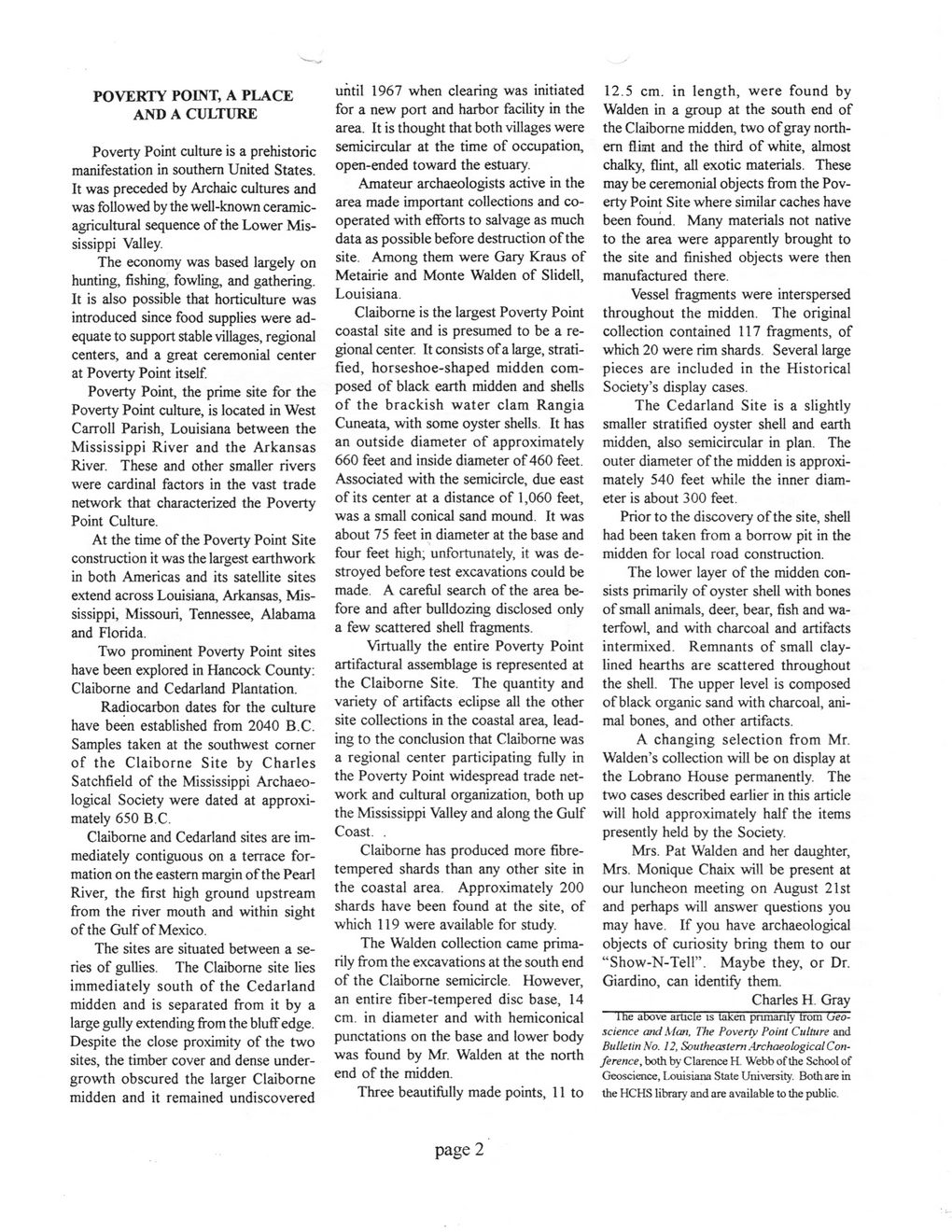This text was obtained via automated optical character recognition.
It has not been edited and may therefore contain several errors.
POVERTY POINT, A PLACE AND A CULTURE Poverty Point culture is a prehistoric manifestation in southern United States. It was preceded by Archaic cultures and was followed by the well-known ceramic-agricultural sequence of the Lower Mississippi Valley. The economy was based largely on hunting, fishing, fowling, and gathering. It is also possible that horticulture was introduced since food supplies were adequate to support stable villages, regional centers, and a great ceremonial center at Poverty Point itself. Poverty Point, the prime site for the Poverty Point culture, is located in West Carroll Parish, Louisiana between the Mississippi River and the Arkansas River. These and other smaller rivers were cardinal factors in the vast trade network that characterized the Poverty Point Culture. At the time of the Poverty Point Site construction it was the largest earthwork in both Americas and its satellite sites extend across Louisiana, Arkansas, Mississippi, Missouri, Tennessee, Alabama and Florida. Two prominent Poverty Point sites have been explored in Hancock County: Claiborne and Cedarland Plantation. Radiocarbon dates for the culture have been established from 2040 B.C. Samples taken at the southwest comer of the Claiborne Site by Charles Satchfield of the Mississippi Archaeological Society were dated at approximately 650 B.C. Claiborne and Cedarland sites are immediately contiguous on a terrace formation on the eastern margin of the Pearl River, the first high ground upstream from the river mouth and within sight of the Gulf of Mexico. The sites are situated between a series of gullies. The Claiborne site lies immediately south of the Cedarland midden and is separated from it by a large gully extending from the bluff edge. Despite the close proximity of the two sites, the timber cover and dense undergrowth obscured the larger Claiborne midden and it remained undiscovered until 1967 when clearing was initiated for a new port and harbor facility in the area. It is thought that both villages were semicircular at the time of occupation, open-ended toward the estuary. Amateur archaeologists active in the area made important collections and cooperated with efforts to salvage as much data as possible before destruction of the site. Among them were Gary Kraus of Metairie and Monte Walden of Slidell, Louisiana. Claiborne is the largest Poverty Point coastal site and is presumed to be a regional center. It consists of a large, stratified, horseshoe-shaped midden composed of black earth midden and shells of the brackish water clam Rangia Cuneata, with some oyster shells. It has an outside diameter of approximately 660 feet and inside diameter of 460 feet. Associated with the semicircle, due east of its center at a distance of 1,060 feet, was a small conical sand mound. It was about 75 feet in diameter at the base and four feet high; unfortunately, it was destroyed before test excavations could be made. A careful search of the area before and after bulldozing disclosed only a few scattered shell fragments. Virtually the entire Poverty Point artifactural assemblage is represented at the Claiborne Site. The quantity and variety of artifacts eclipse all the other site collections in the coastal area, leading to the conclusion that Claiborne was a regional center participating fully in the Poverty Point widespread trade network and cultural organization, both up the Mississippi Valley and along the Gulf Coast. . Claiborne has produced more fibre-tempered shards than any other site in the coastal area. Approximately 200 shards have been found at the site, of which 119 were available for study. The Walden collection came primarily from the excavations at the south end of the Claiborne semicircle. However, an entire fiber-tempered disc base, 14 cm. in diameter and with hemiconical punctations on the base and lower body was found by Mr. Walden at the north end of the midden. Three beautifully made points, 11 to 12.5 cm. in length, were found by Walden in a group at the south end of the Claiborne midden, two of gray northern flimt and the third of white, almost chalky, flint, all exotic materials. These may be ceremonial objects from the Poverty Point Site where similar caches have been found. Many materials not native to the area were apparently brought to the site and finished objects were then manufactured there. Vessel fragments were interspersed throughout the midden. The original collection contained 117 fragments, of which 20 were rim shards. Several large pieces are included in the Historical Society?s display cases. The Cedarland Site is a slightly smaller stratified oyster shell and earth midden, also semicircular in plan. The outer diameter of the midden is approximately 540 feet while the inner diameter is about 300 feet. Prior to the discovery of the site, shell had been taken from a borrow pit in the midden for local road construction. The lower layer of the midden consists primarily of oyster shell with bones of small animals, deer, bear, fish and waterfowl, and with charcoal and artifacts intermixed. Remnants of small clay-lined hearths are scattered throughout the shell. The upper level is composed of black organic sand with charcoal, animal bones, and other artifacts. A changing selection from Mr. Walden?s collection will be on display at the Lobrano House permanently. The two cases described earlier in this article will hold approximately half the items presently held by the Society. Mrs. Pat Walden and her daughter, Mrs. Monique Chaix will be present at our luncheon meeting on August 21st and perhaps will answer questions you may have. If you have archaeological objects of curiosity bring them to our ?Show-N-Tell?. Maybe they, or Dr. Giardino, can identify them. Charles H. Gray 1 he above article is taken primarily trom Ueo-science and Man, The Poverty Point Culture and Bulletin No. 12, Southeastern Archaeological Conference, both by Clarence H. Webb of the School of Geoscience, Louisiana State University. Both are in the HCHS library and are available to the public. page 2

Walden 058